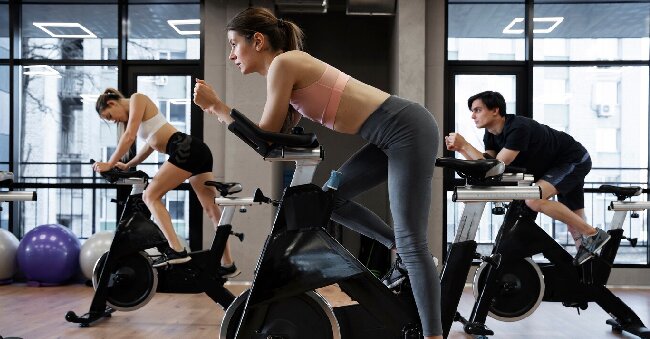
Boost Your Indoor Cycling Performance: 5 Effective Workouts to Enhance Your Routine
Are you looking to take your indoor cycling workouts to the next level?
This article explores what indoor cycling is all about, how it can improve your performance, and the different types of workouts you can incorporate into your routine.
From endurance rides to sprints and cadence drills, we cover it all.
Plus, we provide tips on creating an effective workout plan and highlight the numerous benefits of indoor cycling.
Get ready to boost your performance and achieve your fitness goals!
What Is Indoor Cycling?
Indoor cycling involves stationary biking within a controlled environment, aiming to enhance performance, boost fitness levels, and achieve specific workout goals using specialized indoor bikes. It incorporates various cycling techniques guided by instructors to maximize fitness benefits and leverage the advantages of indoor cycling for improved health and well-being.
Indoor cycling has gained popularity due to its ability to provide a challenging workout while being low-impact, making it suitable for individuals of all fitness levels.
With proper techniques and instructor guidance, participants can adjust resistance levels and speed to customize their workout intensity and target different muscle groups.
This dynamic workout not only helps in burning calories and improving cardiovascular health but also boosts endurance and strength.
The supportive group environment in indoor cycling classes adds motivation and a sense of community, fostering consistency in fitness routines for overall well-being.
How Does Indoor Cycling Improve Performance?
Indoor cycling enhances performance through structured training sessions that focus on improving endurance, speed intervals, resistance levels, and overall strength. Cardiovascular benefits are achieved through intense cycling workouts led by experienced instructors, optimizing power output and RPM for increased efficiency and performance gains.
In these sessions, instructors play a crucial role in guiding participants to push their physical limits, gradually increasing resistance levels to build strength and endurance. Speed intervals are strategically incorporated to improve cardiovascular performance and boost calorie-burning potential. The dynamic nature of indoor cycling allows for a varied workout that targets different muscle groups, enhancing overall fitness levels. By monitoring metrics such as power output and RPM, instructors can provide real-time feedback to help individuals fine-tune their technique and performance outcomes.
What Are the Different Types of Indoor Cycling Workouts?
Indoor cycling workouts encompass a variety of styles including endurance rides, intervals, hill climbs, sprints, and cadence drills, each tailored to specific training objectives. Participants can enhance their sessions with energizing music playlists, fostering motivation, energy levels, and progress tracking to monitor improvements in fitness levels.
In addition to the different styles of workouts, focusing on pedal stroke techniques can boost efficiency and reduce the risk of injury during rides. By mastering smooth, circular pedal strokes, riders can distribute power evenly and engage different muscle groups effectively. Cadence variations, such as high cadence drills for speed and low cadence for strength, add versatility to training routines.
Incorporating diverse music playlists tailored to the workout intensity can elevate the overall experience, keeping participants engaged and driven towards their fitness goals.
Endurance Rides
Endurance rides are extended indoor cycling sessions designed to improve cardiovascular fitness, endurance levels, and overall stamina. Participants focus on maintaining target heart rates, staying hydrated, and engaging various muscle groups consistently to achieve their fitness goals.
These structured sessions help individuals align their fitness goals with specific workout routines that target endurance building. By incorporating varying intensity levels and managing heart rate zones effectively, participants can enhance their cardiovascular capacity and endurance over time.
Staying properly hydrated during these rides is crucial to sustaining performance and preventing fatigue. Engaging key muscle groups such as the quadriceps, hamstrings, and glutes ensures that the body is working efficiently to maintain endurance and achieve lasting results.
Intervals
Interval training in indoor cycling involves alternating between high-intensity efforts and recovery periods, challenging participants to push their limits and improve cardiovascular endurance. It targets core strength, leg muscles, and incorporates cooldown phases to aid in recovery and muscle relaxation.
By incorporating high-intensity intervals, cyclists can maximize their workout efficiency by boosting their heart rate, which leads to enhanced calorie burn and faster metabolism. The core engagement required during the intense intervals helps in better stability and balance, improving overall posture and preventing injuries.
The repetitive high-intensity bursts during interval training stimulate muscle growth and strength in the legs, enhancing power output and endurance during rides. The inclusion of cooldown periods ensures that the body gradually returns to a rest state, preventing muscle fatigue and allowing for a smoother transition into the next workout session.
Hill Climbs
Hill climbs simulate outdoor uphill challenges in indoor cycling, focusing on strength development, gear optimization, proper warm-up routines, and effective stretching exercises. Participants engage in uphill resistance training to enhance muscle endurance and overall cycling performance.
During hill climbs, cyclists carefully select their gear ratios to navigate the challenging inclines, ensuring efficient power transfer and stamina preservation. Warming up before intense hill sessions is crucial to prepare the body for the increased demand on muscles and cardiovascular system. Stretching exercises play a vital role in improving muscle flexibility, reducing the risk of strains and enhancing the overall range of motion for a smoother ride.
Sprints
Sprints in indoor cycling involve short bursts of high-speed pedaling interspersed with recovery periods, targeting speed intervals and cardiovascular fitness. Proper cycling shoes, breathing techniques, and community support enhance the sprinting experience and performance outcomes for participants.
- Incorporating speed intervals into indoor cycling sprints helps build endurance and improve overall speed capacity.
- Selecting appropriate cycling shoes is crucial to maximize power transfer and efficiency during intense pedaling sessions.
- Focusing on breathing techniques such as deep diaphragmatic breathing can enhance oxygen intake and muscle performance while sprinting.
- Engaging with the cycling community not only provides motivation and support but also opens up opportunities for group rides and shared experiences to further enhance skill development and enjoyment of indoor cycling sprints.
Cadence Drills
Cadence drills in indoor cycling emphasize pedaling cadence variations to improve cycling efficiency, posture alignment, heart rate monitoring, and calorie burn tracking. Participants refine their pedaling technique, maintain proper posture, monitor heart rates, and manage calorie expenditure during cadence-focused workouts.
These drills play a vital role in enhancing overall cycling performance by fine-tuning the synchronization between pedaling speed and resistance levels. Through consistent practice, cyclists can not only improve their cardiovascular fitness but also enhance their muscular endurance. By paying close attention to their cadence and posture, individuals can optimize their pedaling mechanics, ensuring a smoother and more efficient ride. Monitoring heart rate fluctuations helps participants gauge their exertion levels, enabling them to adjust their intensity to stay within their target training zones for maximum cardiovascular benefits.
How to Create an Effective Indoor Cycling Workout Plan?
Creating an effective indoor cycling workout plan involves setting specific goals, varying workout styles, incorporating strength training, and ensuring proper cooldown routines for enhanced performance and fitness results.
When establishing your goals, it’s essential to consider factors like endurance, speed, and overall improvement. By diversifying your workout routines, you keep your sessions engaging and challenging, targeting different muscle groups and preventing plateaus. Integrating strength exercises, such as squats, lunges, and core workouts, helps build muscle strength and endurance, enhancing your cycling performance.
Structured cooldown protocols are crucial for aiding recovery, reducing muscle soreness, and promoting flexibility. These post-workout routines can include gentle stretches, foam rolling, and relaxation techniques to optimize your overall fitness gains.
Set Specific Goals
Setting specific goals in indoor cycling provides a clear direction for personal challenges, fitness level improvements, and progress tracking. It motivates individuals to push their boundaries and achieve measurable milestones in their cycling journey.
By establishing goals, one can create a roadmap tailored to their unique strengths and areas needing improvement. This helps in setting realistic challenges that keep the workout engaging and effective.
Tracking progress not only provides a sense of accomplishment but also allows for adjustments to optimize performance. Leveraging motivational factors such as music, virtual cycling classes, or friendly competitions can further boost determination and drive towards surpassing fitness barriers.
Vary Your Workouts
Diversifying indoor cycling workouts is essential to maintain motivation, energy levels, and engagement. Incorporating different styles, energizing music playlists, and challenging routines helps prevent monotony and boosts overall workout enjoyment.
Variety in indoor cycling not only keeps the sessions exciting but also plays a crucial role in preserving energy levels. Mixing up your routines helps target different muscle groups, preventing burnout and reducing the risk of overuse injuries.
Personalizing your music playlists can provide a significant energy boost during intense intervals or climbs, making the workout more enjoyable and empowering. Introducing new challenges like interval sprints or hill climbs keeps the mind engaged and the body challenged, leading to more effective and exhilarating indoor cycling sessions.
Incorporate Strength Training
Integrating strength training into indoor cycling routines enhances muscle development, core strength, and overall cycling performance. Participants focus on engaging various muscle groups, optimizing core strength, and implementing hydration strategies to support strength building during workouts.
By incorporating targeted core strengthening exercises, riders can improve their stability and power on the bike, leading to better performance and reduced risk of injury.
Cycling gear designed for resistance training, such as weighted vests or cycling gloves with added grip, can add an extra challenge to workouts, enhancing muscle engagement and overall strength development.
Staying properly hydrated is crucial for muscle recovery and growth, aiding in the replenishment of essential nutrients and the removal of waste products from muscles post-workout.
Listen to Your Body
Listening to your body during indoor cycling workouts is crucial for injury prevention, recovery optimization, and overall well-being. Paying attention to breathing techniques, effective cooldowns, and proper warm-ups ensures a safe and productive cycling experience.
By tuning into signals your body sends during the ride, you can adjust your intensity levels and posture to prevent strains and overexertion.
Prioritizing recovery post-workout by incorporating stretching routines and hydration helps muscles repair and prevents stiffness.
Focusing on controlled breathing not only enhances performance but also aids in relaxation and mental focus.
Implementing thorough cooldowns with gentle movements and stretching can reduce the risk of muscle cramps and enhance flexibility.
Initiating a proper warm-up routine primes your body for the workout ahead, reducing the likelihood of injuries and improving overall performance sustainability.
What Are the Benefits of Indoor Cycling?
Indoor cycling offers numerous benefits including low impact on joints, improved cardiovascular endurance, enhanced leg strength, efficient calorie burning, and the flexibility to participate in a cycling community or virtual cycling platforms for varied experiences.
In addition to being joint-friendly, indoor cycling is a fantastic way to boost your heart health as it gets your blood pumping and strengthens your heart muscle.
The constant pedaling action not only works wonders for your legs, but also helps in toning your lower body muscles.
The high-intensity nature of indoor cycling sessions makes it a highly effective calorie-burning workout, aiding in weight management and overall fitness goals.
Engaging with the cycling community or joining virtual platforms provides a sense of camaraderie, motivation, and an opportunity to explore different cycling environments for a more enriching experience.
Low Impact on Joints
Indoor cycling is known for its low impact on joints, promoting joint health through proper posture, suitable cycling shoes that reduce impact, and facilitating post-workout recovery. It offers a joint-friendly exercise option for individuals with varying fitness levels.
Maintaining a good posture while cycling indoors is crucial not only for optimizing performance but also for minimizing stress on the joints. By ensuring that the bike is properly adjusted to fit your body mechanics, you can prevent strain and potential injuries.
Investing in proper cycling shoes with adequate support and cushioning can further reduce the impact on your joints, enhancing overall comfort and stability during your rides.
After a cycling session, incorporating stretching exercises and relaxation techniques can aid in post-workout recovery, helping to alleviate any muscle tension and maintain joint health for the long term.
Cardiovascular Endurance
Indoor cycling boosts cardiovascular endurance by elevating heart rates, balancing energy expenditure, and facilitating warm-up routines to prepare the body for intense workouts. Monitoring heart rates optimizes cardiovascular benefits and performance outcomes.
The sustained increase in heart rate during indoor cycling sessions not only improves the efficiency of the heart in pumping blood but also enhances overall cardiovascular health. By engaging in this high-energy activity, individuals can manage their energy levels effectively, gradually building up their endurance and stamina.
Incorporating a thorough warm-up session before delving into the main workout not only reduces the risk of injuries but also primes the muscles and cardiovascular system for optimal performance.
Heart rate monitors serve as valuable tools for tracking and analyzing the impact of indoor cycling on one’s cardiovascular fitness levels, allowing individuals to make informed adjustments to their routines for maximizing the benefits.
Builds Leg Strength
Indoor cycling is effective in building leg strength by engaging major muscle groups, incorporating strength-building techniques, selecting appropriate cycling gear for resistance, and emphasizing stretching exercises for muscle flexibility and recovery. It targets leg muscles for enhanced lower body strength.
During indoor cycling sessions, the quadriceps, hamstrings, glutes, and calves are actively involved, resulting in a comprehensive leg workout. By adjusting the resistance on the bike, individuals can increase the challenge on these muscles, promoting strength development. Choosing the right gear, such as cycling shoes and pedal clips, enhances the efficiency of each pedal stroke, leading to greater muscle engagement.
To prevent muscle tightness and aid recovery, incorporating post-ride stretching routines is essential for improving flexibility and reducing the risk of injury.
Burns Calories
Indoor cycling is an efficient calorie-burning activity that maximizes caloric expenditure through optimized heart rate management, tracking calories burned, and ensuring proper hydration levels for sustained performance. It offers a high-energy workout with significant calorie burn potential.
When engaging in indoor cycling, individuals have the opportunity to fine-tune their heart rate control for optimal calorie burn, as maintaining the right intensity can increase the number of calories expended during each session. By tracking calories burned using fitness trackers or monitors, cyclists can monitor their progress and adjust their workout intensity to meet their calorie-burning goals.
Staying hydrated during intense cycling sessions is crucial for maintaining energy levels and performance, as dehydration can impede calorie burn and overall workout effectiveness.
Can Be Done Anytime, Anywhere
One of the notable benefits of indoor cycling is its versatility, allowing individuals to engage in workouts anytime and anywhere, reaping the fitness benefits, staying motivated, and embracing the challenge of indoor cycling routines conveniently.
It’s the ultimate fitness solution that fits seamlessly into busy schedules, letting you break a sweat and push your limits at your own pace. Whether you prefer early morning rides to kickstart your day, midday escapes to rejuvenate your energy, or late-night sessions to unwind, indoor cycling ensures you can always squeeze in a workout. The accessibility of various workout programs and virtual classes adds an element of excitement and motivation, making each ride an immersive experience that keeps you coming back for more, fostering consistent engagement for your fitness journey.




No Comments